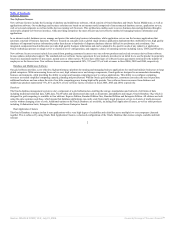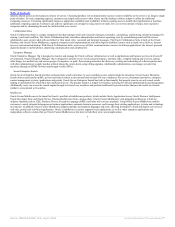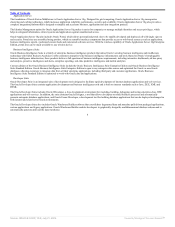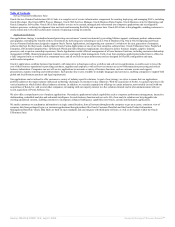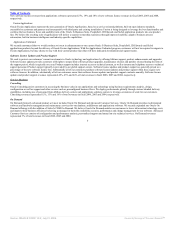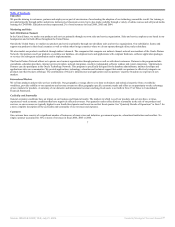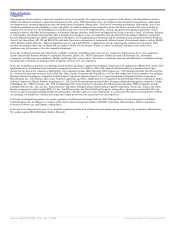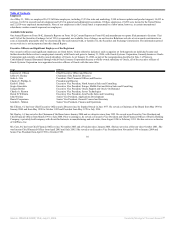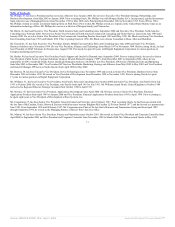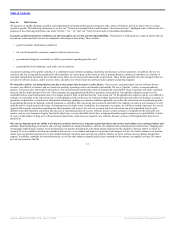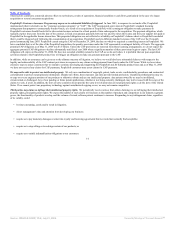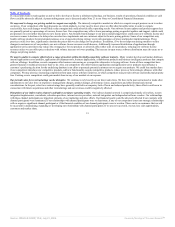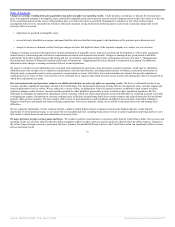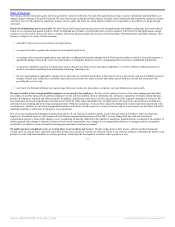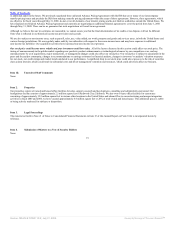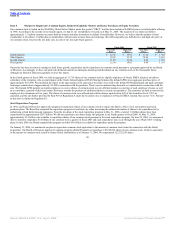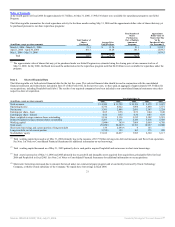Oracle 2005 Annual Report Download - page 15
Download and view the complete annual report
Please find page 15 of the 2005 Oracle annual report below. You can navigate through the pages in the report by either clicking on the pages listed below, or by using the keyword search tool below to find specific information within the annual report.
Table of Contents
Item 1A. Risk Factors
We operate in a rapidly changing economic and technological environment that presents numerous risks, many of which are driven by factors that we cannot
control or predict. The following discussion, as well as our “Critical Accounting Policies and Estimates” discussion in Item 7, highlights some of these risks. For
purposes of the following risk factors, the terms “Oracle,” “we,” “us” and “our” refer to Oracle and its consolidated subsidiaries.
Economic, political and market conditions can adversely affect our revenue growth and profitability. Our business is influenced by a range of factors that are
beyond our control and that we have no comparative advantage in forecasting. These include:
• general economic and business conditions;
• the overall demand for enterprise computer software and services;
• governmental budgetary constraints or shifts in government spending priorities; and
• general political developments, such as the war on terrorism.
A general weakening of the global economy, or a curtailment in government spending, could delay and decrease customer purchases. In addition, the war on
terrorism, the war in Iraq and the potential for other hostilities in various parts of the world, as well as natural disasters, continue to contribute to a climate of
economic and political uncertainty that could adversely affect our revenue growth and results of operations. These factors generally have the strongest effect on
our sales of software licenses, and to a lesser extent, also affect our renewal rates for software license updates and product support.
We may fail to achieve our financial forecasts due to inaccurate sales forecasts or other factors. Our revenues, and particularly our new software license
revenues, are difficult to forecast, and as a result our quarterly operating results can fluctuate substantially. We use a “pipeline” system, a common industry
practice, to forecast sales and trends in our business. Our sales personnel monitor the status of all proposals and estimate when a customer will make a purchase
decision and the dollar amount of the sale. These estimates are aggregated periodically to generate a sales pipeline. Our pipeline estimates can prove to be
unreliable both in a particular quarter and over a longer period of time, in part because the “conversion rate” of the pipeline into contracts can be very difficult to
estimate. A contraction in the conversion rate, or in the pipeline itself, could cause us to plan or budget incorrectly and adversely affect our business or results of
operations. In particular, a slowdown in information technology spending or economic conditions generally can reduce the conversion rate in particular periods
as purchasing decisions are delayed, reduced in amount or cancelled. The conversion rate can also be affected by the tendency of some of our customers to wait
until the end of a fiscal period in the hope of obtaining more favorable terms. In addition, for companies we acquire, we will have limited experience for several
quarters following the acquisition regarding how their pipelines will convert into sales or revenues and their conversion rate post-acquisition may be quite
different from their historical conversion rate. Because a substantial portion of our new software license revenue contracts is completed in the latter part of a
quarter, and our cost structure is largely fixed in the short term, revenue shortfalls tend to have a disproportionately negative impact on our profitability. A delay
in even a small number of large new software license transactions could cause our quarterly new software licenses revenues to fall significantly short of our
predictions.
Our success depends upon our ability to develop new products and services, integrate acquired products and services and enhance our existing products and
services. Rapid technological advances and evolving standards in computer hardware, software development and communications infrastructure, changing and
increasingly sophisticated customer needs and frequent new product introductions and enhancements characterize the enterprise software market in which we
compete. If we are unable to develop new products and services, or to enhance and improve our products and support services in a timely manner or to position
and/or price our products and services to meet market demand, customers may not buy new software licenses or renew software license updates and product
support. In addition, standards for network protocols, as well as other industry adopted and de facto standards for the internet, are rapidly evolving. We cannot
provide any assurance that the
12
Source: ORACLE CORP, 10-K, July 21, 2006 Powered by Morningstar® Document Research℠


